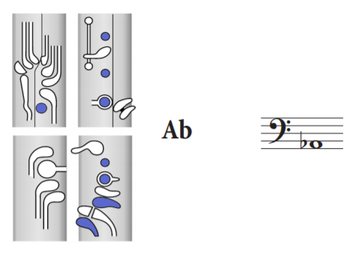A Hidden Logic
What is with all of these keys?
The bassoon looks very daunting, but in actuality it follows the same fingering system logic as all other six finger woodwinds - yes, just like a flute or single reed! Check out this exploration of the "three big ideas" of woodwind fingering systems. Most basically, the bassoon has so many keys simply because our fingers are not long enough to reach the position where the hole through the bore should be in order to produce such low tones.
On the bassoon the six fingers are the three open tone holes on the wing joint - responsible for E, D, and C in bass clef - and the first two tone holes and ring finger key in the right hand - responsible for B, A, and G in bass clef. All other keys are for either:
The principles of bassoon fingerings in the first year can be boiled down to the following:
To this end, it is actually quite useful for your bassoonists to start chromatic patterns early! There is a physical rhythm that comes from feeling the "on-off" alteration of pinky and thumb keys that helps make the system feel more intuitive.
The bassoon looks very daunting, but in actuality it follows the same fingering system logic as all other six finger woodwinds - yes, just like a flute or single reed! Check out this exploration of the "three big ideas" of woodwind fingering systems. Most basically, the bassoon has so many keys simply because our fingers are not long enough to reach the position where the hole through the bore should be in order to produce such low tones.
On the bassoon the six fingers are the three open tone holes on the wing joint - responsible for E, D, and C in bass clef - and the first two tone holes and ring finger key in the right hand - responsible for B, A, and G in bass clef. All other keys are for either:
- extending the range (left hand thumb, right hand pinky)
- chromatic alterations (left hand pinky, right hand thumb)
The principles of bassoon fingerings in the first year can be boiled down to the following:
- opening tone holes raises pitch, even if this means pressing down a key to open the hole
- index, middle, and ring fingers produce "white key" notes
- pinkies and thumbs largely produce "black key" notes
To this end, it is actually quite useful for your bassoonists to start chromatic patterns early! There is a physical rhythm that comes from feeling the "on-off" alteration of pinky and thumb keys that helps make the system feel more intuitive.
Gaming the System
The biggest problem for beginning bassoonists in band is that concert band pedagogy was not designed for them - it was largely designed to serve the masses, the B-flat pitched instruments and woodwinds where the break occurs one step higher than on the bassoon. To help this, I modify initial note introduction to the sequence below, which highlights similarities in fingerings:
C, D, and F - Left Hand Home Base
B-flat and E-flat: Right Hand Partners
A, G, and F - Right Hand Walk Down
A-flat - Chromatic Pinky
This also builds the scaffold for the upcoming break navigation! You could introduce F-sharp here, as well.







